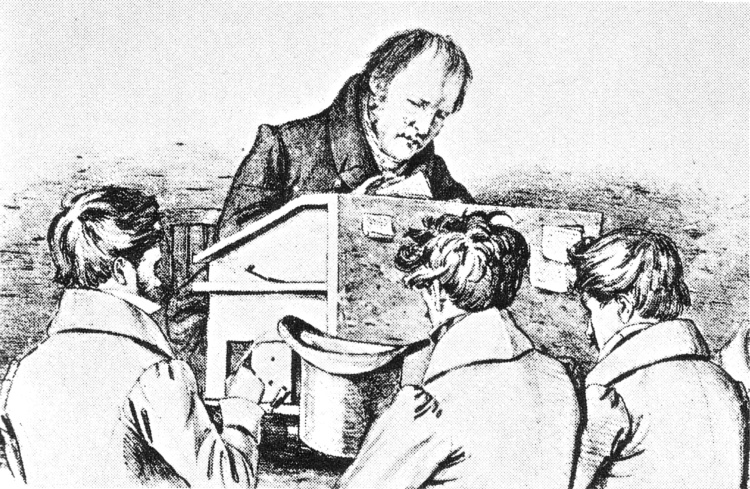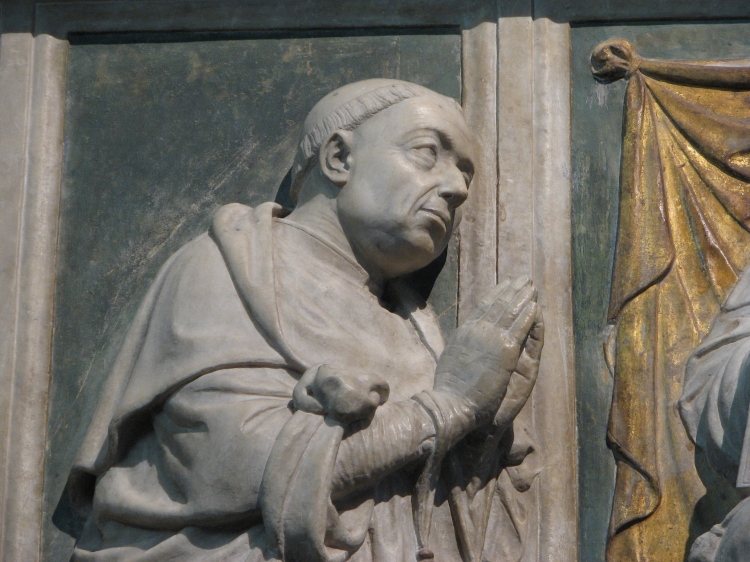
Hegel (1770-1831) with his Berlin students, Sketch by Franz Kugler
29.07.14
What Hegel read but never acknowledged and what all the academics missed. Why?
No direct connection has ever been established between Nicholas of Cusa and Hegel. It has been accepted that Hegel did not know of him.1 In fact, there is clear evidence that Hegel knew of Cusanus, and in detail. Not only did Bruno twice specifically refer to him, and with the highest praise, Buhle, whose history Hegel read, discussed Cusanus at length, citing all of his most important works.
In the first volume of his Lectures on the Philosophy of Religion Hegel quoted Eckhart from one of his sermons – ‘The eye with which God sees me is the eye with which I see him.’2 In volume III of his Lectures on the History of Philosophy Hegel discussed Böhme – ‘the first German philosopher’ the reading of whose works was ‘wondrous,’ over eleven pages,3 giving five pages in the same volume to Bruno, yet he never even mentioned Cusanus – a figure in the German mystical tradition between Eckhart and Böhme.
But the ‘divine’ Cusanus who Bruno named, ‘the inventor of geometry’s most beautiful secrets,’ is Bruno’s guide in Cause, Principle and Unity,4 in which Bruno referred to key aspects of Cusanus’ philosophy. Bruno again named and referred to Cusanus as ‘divine’ in The Ash Wednesday Supper, citing his single most important treatise, De Docta Ignorantia.5
Particularly, in the same volume of his Lectures on the History of Philosophy, Hegel wrote simply of Bruno ‘The fullest information about him is to be found in Buhle’s history of philosophy.’6 In that extremely interesting work (not only because of the sections on Cusanus but because in it Buhle discusses the impact of Neoplatonism, Kabbalism and Hermeticism in general on German philosophy) Buhle wrote on Cusanus in detail, naming his most significant treatises.7
Why did Hegel never even name Cusanus, in any of his writing – a man who was far more philosophical, and in the ‘Hegelian manner,’ than either Eckhart and particularly Böhme, of whom Hegel also wrote that his articulation was ‘unmistakably barbarous’ and that he ‘grasps the antitheses in the harshest, crudest fashion’?8

Nicholas of Cusa (1401-1464). From a painting by Meister des Marienlebens (Master of the Life of the Virgin), located in the hospital at Kues (Germany)
My contention in my thesis will be that Hegel never named Cusanus, not only because he was so indebted to one who was known to be a Christian mystic/Neoplatonist (I have identified more than thirty points in the philosophy of Cusanus which occur in that of Hegel), but because to do so would immediately open to question the nature of Hegel’s vaunted concepts (several of which, I will contend, came directly from Cusanus), the apparent intellectual rigour of his philosophy, and particularly, the meaning of his ‘reason’ – his claims to and for it.
In denying through his utter silence the significance of Cusanus and the foresight of his genius, Hegel was emblematic not only of the German intellectuals of his time (with regard to Spinoza then Swedenborg and Oetinger and later, Nietzsche with regard to ‘Saint Max’ Stirner) but of Western culture as a whole – suppressing key elements of our history, of what has made us, so that we may perceive ourselves, as Hegel did, the bearers and masters of ‘Reason.’9
We of the West believe it has been our ‘reason’ – understood as linguistic, conceptual and particularly propositional – that has enabled us to achieve so much and attain global domination. Mysticism, the myth goes, was only a stage that was shed long ago.
What if ‘reason’ were understood to function not only linguistically, conceptually and propositionally (the reason of patriarchy) but in a manner that has been relegated to and powerfully utilised in the mystical, in ‘the feminine’?
What if philosophers were to be materialists (Heaven forbid!) and recognise, consistent with science, that our brains function wholistically in relation to the world – and philosophise honestly about ‘reason’ on that material basis?
What would happen to our belief in our supremacy then – even as Asia rises?
And what new areas for philosophy might be opened up?
Part one/to be continued…
In subsequent posts I will publish a translation of Buhle’s writing on Cusanus.

Notes
1. ‘…Nicholas of Cusa (whom Hegel surprisingly never mentions)…’ Michael Inwood, A Hegel Dictionary, Blackwell, Oxford, 1992, 140. Magee, citing Beck, wrote ‘we know that Schelling was influenced by reading Nicholas (Lewis White Beck, Early German Philosophy: Kant and his Predecessors, The Belknap Press, Cambridge, Massachusetts, 1969, 71)…However, Hegel never mentions Cusa anywhere in his published writings or in his lectures.’ In the footnote to this Magee (who otherwise writes excellently on the relationship between Hegel, mysticism and Hermeticism, arguing that Hegel was an Hermetic mystic) expressed a standard view ‘David Walsh notes that although there is no evidence that Hegel ever read Cusa, he was indirectly influenced by him through J.G.Hamann and Giordano Bruno.’ Glenn Alexander Magee, Hegel and the Hermetic Tradition, Cornell University Press, Ithaca, 2001, 28. Redding wrote ‘In Hegel’s case, Spinozistic and Cusan elements (were) reflected through the speculative thought of Schelling,’ Paul Redding, Hegel’s Hermeneutics, Cornell University Press, Ithaca, 1996, 31, also ‘Jacobi had not only introduced the German reading public to Spinoza but also to Giordano Bruno, and thereby, indirectly to Nicholas of Cusa.’ Paul Redding, Continental Idealism: Leibniz to Nietzsche, Routledge, London, 2009, 126. Hodgson wrote ‘Hegel was familiar with Bruno through Schelling’s work as well as that of J.G.Buhle and F.H.Jacobi,’ Peter C. Hodgson, Ed., G.W.F. Hegel, Theologian of the Spirit, Fortress, Minneapolis, 2007, 274. Jasper Hopkins wrote ‘Nicholas does not anticipate, prefigure, foreshadow, etc., Kant, so also he does not anticipate Copernicus or Spinoza or Leibniz or Berkeley or Hegel. …In retrospect, Nicholas must be regarded as a transitional figure some of whose ideas (1) were suggestive of new ways of thinking but (2) were not such as to conduct him far enough away from the medieval outlook for him truly to be called a Modern thinker. Spinoza, Kant, and Hegel never mention him, although Kepler, Descartes, and Leibniz do. …Nicholas’s intellectual influence on his own generation and on subsequent generations remained meager.’ Jasper Hopkins, ‘Nicholas of Cusa (1401-1464): First Modern Philosopher?’, Renaissance and Early Modern Philosophy, Midwest Studies in Philosophy, Vol. 26 (2002), pp. 13-29, 28-29. ↩
2. The editor wrote that Hegel was familiar with the writing of Eckhart from 1794. G.W.F. Hegel, Lectures on the Philosophy of Religion vol. I, Ed. Peter C. Hodgson, Trans., R.F.Brown, P.C.Hodgson, J.M.Stewart, Clarendon Press, Oxford, 2007, 347 ↩
3. G.W.F. Hegel, Lectures on the History of Philosophy 1825-6 Volume III Medieval and Modern Philosophy, Trans. Robert F. Brown and J.M. Stewart, Clarendon Press, Oxford, 2009, p. 95 ↩
4. Giordano Bruno, Cause, Principle and Unity (De la causa, principio e uno, 1584), Trans. and Ed., Robert de Lucca and Essays on Magic, Trans. and Ed., Richard J. Blackwell, Cambridge University Press, Cambridge, 2004, pp. 96-7 ↩
5. Giordano Bruno, The Ash Wednesday Supper (La Cena de le Ceneri, London, 1584), Ed. and Trans., Edward A. Gosselin and Lawrence S. Lerner, University of Toronto Press, Toronto, 1995, pp. 139, 150 ↩
6. G.W.F. Hegel, Lectures on the History of Philosophy 1825-6 Volume III, op. cit., p. 62 ↩
7. Johann Gottlieb Buhle, Geschichte der neuern Philosophie seit der Epoche der Widerherstellung der Wissenschaften, vol. 2, Johann Georg Rosenbusch, Göttingen, 1800, p. 81 and p. 342ff ↩
8. G.W.F. Hegel, Lectures on the History of Philosophy 1825-6 Volume III, op. cit., p. 103 ↩
9. Plotinus wrote his phenomenology of consciousness rising not through its ‘shapes’ or (with a Christian patina) ‘stations’ but hypostases one and a half thousand years before Hegel’s. ↩
English translations of the works of Cusanus by Jasper Hopkins


















